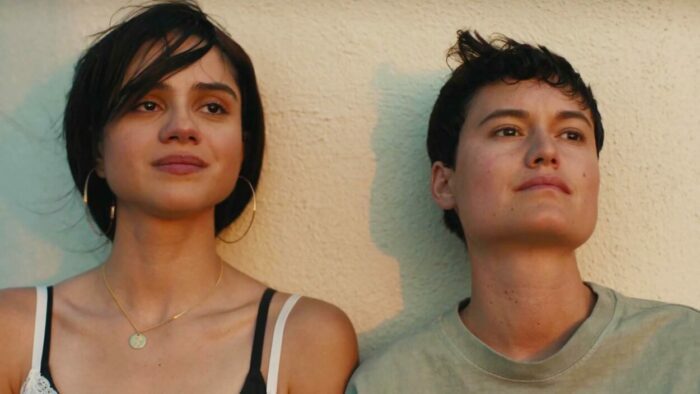Coming-of-age for depictions of fraught childhoods carry with them both a distinct breed of tension and longing—something that a recent crop of films have made good use of, especially when adolescent femininity crosses with complicated fatherhood. Debra Granik’s Leave No Trace shows a father suffering from wartime PTSD living off the grid with his daughter. Charlotte Wells’s Aftersun traces back a daughter’s memories of a single, and implicitly final, summer vacation spent with her quietly distressed father. Both seem to have found a kind of successor in Alessandra Lacorazza Samudio’s Sundance Grand Jury Prize-winning In the Summers, which grounds itself in two sisters’ bond to the backdrop of Las Cruces, New Mexico under the shadow of a father whose volatility is only as consistent as his love for his daughters.
Given how neatly the broad strokes of the film fit into that aforementioned mold, there isn’t that much narratively separating In the Summers from both its predecessors and contemporaries. It’s what the film manages to mine from in-between the lines that manages to make it stand out, separating its story of development under turmoil into four narrative sequences that trace the full growth of two sisters’ early lives. This is the story of Violeta (Dreya Renae Castillo, Kimaya Thais Limón, and Lío Mehiel), Eva (Luciana Quinonez, Allison Salinas, and Sasha Calle), and Vicente (Calle 13 founding member Residente), and the silent ways that the lattermost’s internal darkness gradually erodes at the relationships they build with each other.

Most of the film, playing at the 2024 Tribeca Film Festival, is set within the confines of Vicente’s mother’s old home, which he grows to own at the beginning of the film, and gradually takes on different shapes as time further passes by. Samudio demonstrates a strong knack for gradually building up breadcrumbs. The first chapter of the film, during which the sisters are in their early childhoods, is mostly full of adoration, with Vicente demonstrably wanting to take good care of his daughters throughout. Yet, the mask slips once or twice. He chews out and curses at a woman who asks if a motion-sickened Eva is okay after an amusement park ride, and once drives the girls home while inebriated, swerving recklessly on the road to an oblivious Eva’s joy and Violeta’s terror.
Gradually, as the mask slips more often, the silence between the family grows more distinct, and the gaps between the summers that the two sisters visit their father become more chasmic over time. Violeta starts to develop a mind of her own as well as a distinct queer identity, standing up more often to her father, whose tries forcefully to defend his masculine pride. Eva more openly expresses a desire to connect with Vicente, but there’s a clear preference he shows both to the more academically talented Violeta as well as the attachments he develops to new partners after an implied divorce.
Among In the Summers’ most distinct traits is the way different spaces evolves over time—also pointed at by the presence of shrine-like collections of artifacts and signifiers of transition in these characters’ lives that underlay each chapters’ title cards. Small things each of the characters make for, demonstrate to, and offer each other steadily become recurring images over the years, most prominent among them being the pool in the house’s backyard that steadily deteriorates over time from underuse and lack of care. Also, a frequent stop for the family is a local bar owned by one of Vicente’s friends, Carmen—someone who grows to be a kind of refuge for Violeta and Eva during Vicente’s more turbulent episodes— and whose bar is a regular place for Vicente to try and show off his pool skills to his daughters.

Those small things also compound in the main three In the Summers performances. The more distinctly minute traits that the characters show remain consistent over time, especially as they impressively translate from one actress to another for both Violeta and Eva, starting from a solid foundation of robust child acting before landing confidently in the hands of The Flash‘s Sasha Calle and Mutt‘s Lio Mehiel. Residente is also a particular standout in a remarkable acting debut for someone who’s existed in the music industry for as long as he has. The level of repression and internal pain he exhibits throughout clearly grows stronger as his worst tendencies are only further entertained, visibly estranging his daughters from him over time, and leaving him implicitly helpless to do anything about that growing absence.
Given the fact that it’s in the minutiae that In the Summers thrives the most, it becomes almost natural by extension that the film essentially works as a slow burn. While there are pivotal moments in which Vicente’s recklessness and volatility bring with them enormous consequences, the film doesn’t dwell so much on what the immediate impact of all of that is, electing instead to move into the ripple effects that last years afterwards. There are instances where that has clearly left an impact, especially in the final stretch of the film, where Violeta and Eva have both grown into adults, and we see most clearly what everything about their complicated relationship with Vicente has left behind—physically, emotionally, and so on. But there are moments where the pacing of the film often stalls, likely a side effect of the fact that in telling a story where no side of this family visibly makes a true attempt to comprehend or empathize with one another, we don’t learn anything wholly new about any of the characters that would cause some kind of productive rupture in the story.
Which leads to the most interesting conclusion to make about In the Summers—this is a film that narratively prioritizes the dynamic between each member of this family more than it does the actual characters themselves. Over time, we understand what Vicente means to his daughters, what Violeta and Eva mean to him, what the two sisters mean to each other; and how all of that has changed by the time the film ends. In honing in solely on that three-way tie of meaning, In the Summers risks losing sight of what or who these characters truly are, independent of each other, and also risks losing sight of what power lies within depicting at least some of the aforementioned change itself.
Perhaps some of that is the point. In families like these, one of the main sources of distress for those who exist in them is that the more harrowing dynamics at play are steadily consuming their daily lives. So much of the content of this film is already designed in a way that provokes thought, and elucidating answers about these characters in an obvious way would clearly do it a major disservice. However, this is a story told through vignettes, and there are lives that these characters demonstrably lead outside of them, especially outside the scope of when they’re in the same space as Vicente over the course of several summers only. To lose out on the details of Violeta and Eva’s lives outside of what we see is to also lose out on how that, in turn, could inform their relationships with their father—a major source of potential that had me craving a story with more rich amounts of the smaller details that the film already knows to handle so well.



